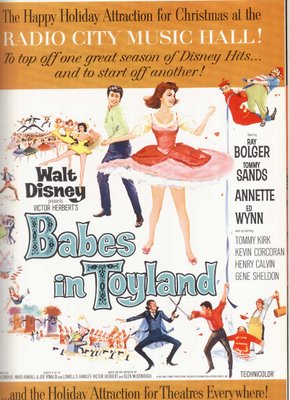
Walt Disney's Babes In Toyland
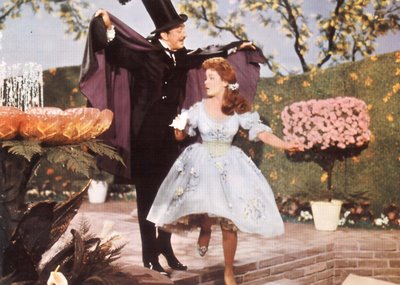
Walking the Greenway last week, I ran into a woman I’ve known most of my life, and she asked me where she could find a copy of Disney’s Babes In Toyland. I told her they were all over Amazon, and we parted upon her vow to have one of these. A few steps distant, I turned and called after her --- "When did you first see Babes In Toyland?" She didn’t have to answer. I knew. "Back when it came out and I was eight years old…" was her immediate reply, "… and I’ve always loved it!" Well, how can you argue with that? Never mind that it’s critically reviled. Star Tommy Sands told me once at a Courts Autograph Show that he fell asleep at the premiere. Even Walt himself was aghast when they first screened it for him --- but there’s no arguing with the cherished memories of one who once was eight and found him/herself entranced with this Christmas 1961 musical event. Any of us alive at that time are certain to remember the massive campaign that heralded its forthcoming release. Babes In Toyland is the first movie I remember being bombarded with. Indeed, I think it was the most extensive promotion of a live-action feature Disney had attempted up to that time, and I’m not forgetting his 1954 juggernaut, 20,000 Leagues Under The Sea. By 1961, the studio had evolved into a model of marketing efficiency --- which makes all the more sobering the fact that this time they were peddling bad merchandise --- and knew it.
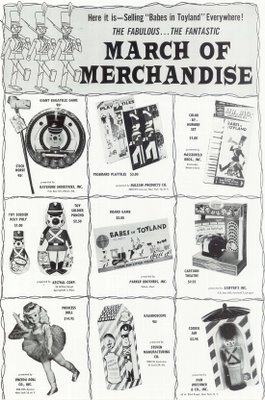
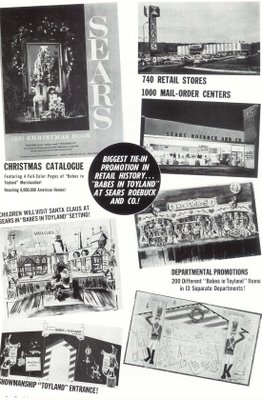
There’s a scene in The Bad and The Beautiful where the movie producer anti-hero, played by Kirk Douglas, watches his just completed (and dreadful) latest effort in a private projection room with his staff. At the end, there’s utter silence. Kirk finally announces he’ll shelve the million-dollar disaster rather than release such a thing with his name on it. His minions raise spirited protest, but Kirk is determined to stand the loss rather than sacrifice his integrity. According to staffers, this is almost precisely the scene that played out for real at the Disney studios when Babes In Toyland was first shown to Walt --- minus the talk of shelving and discussions about integrity. With millions sunk into this fetid well, there was no way he could deep-six Babes In Toyland. "Well, I guess Disney just doesn’t know how to make musicals" was Walt’s crisp summation as he quietly left the screening and its abashed audience of company employees. It was now their unpleasant duty to mount an unprecedented nationwide push for a movie that all but required the services of a fumigator to clear the air of its stench. The final receipts added up to roughly half of what the company had realized for The Shaggy Dog, a black-and-white comedy that had gone out with far less expectations, but the ultimate failure of Babes In Toyland, both commercial and artistic, need not deter us. As far as I’m concerned, it’s the campaign for this movie that enshrines it among the immortals …
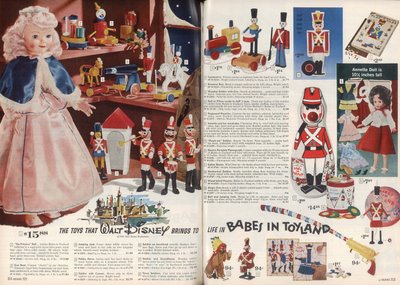

Walt Disney’s Wonderful World Of Color had just premiered in the Fall of 1961 on NBC. Television saturation for Babes In Toyland began on November 13 for a December 14 release date. This would be Disney’s big Christmas release. One entire episode of the NBC series was dedicated to it. Backstage Party featured an avuncular Walt hosting a wrap gathering for Babes In Toyland with most of the cast (including Tommy Sands brazenly enjoying a cigarette!) and liberal samplings from the movie. Broadcast on December 17, 1961, Backstage Party was the first Disney program on the peacock network to specifically hawk a new theatrical release. Needless to say, the audience for a color NBC telecast was considerably larger than the lesser numbers previously delivered by ABC (television programmers today can only dream of the mass audience networks used to routinely attract in those days). Merchandising tie-ups for Babes In Toyland were staggering both in number and variety. The samples I’ve illustrated are mere drops in an ocean of bric-a-brac. The biggest coup for Disney had to be their alliance with Sears for its Christmas Wishbook. Those of you around back then no doubt remember the Wishbook. For every kid with a Santa list, this was where you went to fill it. Babes In Toyland had four pages of coverage. As you can see, every conceivable toy and accessory is there for the asking. Beyond the Sears line, there were books, multiple records, both albums and singles, Viewmaster reels, clothing, board games --- I checked ebay and there’s lots of Babes In Toyland stuff up for auction even as we speak. I guess those landfills could only hold so much at any given time. Has forty-five years been long enough to get rid of all this stuff?
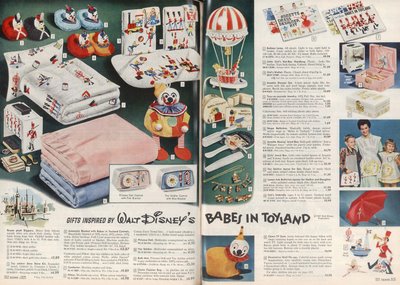
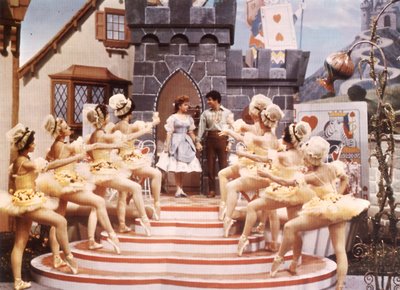

Critics called it Babes In Disneyland. One review said it was all frosting with no cake underneath. They complained that it had no heart --- too mechanical --- there was no danger, no tension, no threat. I read all this before watching Disney's austere DVD (presented in full-frame despite the company’s 1961 directive to showmen that it be presented in 1:75 to 1 --- and no extras). It was tough sledding at times, but putting myself in the place of a child going with family and friends on an outing to the movies in 1961, I can understand how the color and pageantry of the thing would make quite an impression. The fact it panders in such an antiseptic and non-threatening way to the target "family" audience is at least partial explanation for its being so despised today. You really had to be there to stomach this one, and even little kids might go into a hyper-active exit dance after sitting through yet another production number that looks like something that might have opened a typical Jackie Gleason Show. Annette Funicello is plenty fine to look at, but a singer she’s not, and the "double-tracking" they did on her thin voice makes her sound like one of those space aliens addressing Hugh Marlowe in Earth vs. The Flying Saucers. The love scenes between she and Tommy Sands are so chaste as to be ludicrous, and Tom’s standard issue teen idol model, by way of Fabian, Frankie, and a dozen other sexless ciphers, is evidence Disney had no idea how to handle this kind of personality. Ed Wynn, with a neutered Tommy Kirk as his assistant, doesn’t get on until the second half, and a little of him, even in the best of circumstances, will get you to that saturation point quick. Principal villain Ray Bolger is anything but --- if he were any less menacing, he’d be taking pratfalls with woeful comics Henry Calvin and Gene Sheldon (come to think of it, he does). These two guys do nothing other than evoke far more agreeable memories of Laurel and Hardy in the 1934 Babes In Toyland --- as for Calvin, he’d remain our most brazen, and ineffective, Oliver Hardy imitator until Alan Hale, Jr. came along to steal those honors with Gilligan’s Island. That "haunted forest" is about as scary as a petting zoo, and the wrap-up, with toy soldiers attacking a laughing Ray Bolger, amounts to a tepid climax. For all of this, I can still sympathize with my friend Jenny and her fond memories of Babes In Toyland. I only hope seeing it again won’t prove too disillusioning for her. Some childhood memories are best left undisturbed.